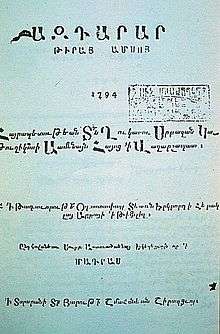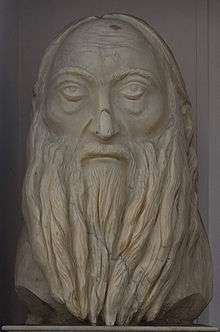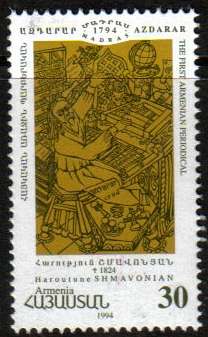Azdarar
Azdarar (Armenian: Ազդարար) (pronounced Aztarar in Western Armenian) was the first Armenian language newspaper ever published. It was established on October 16, 1794 in the city of Madras (now Chennai) in India by Father Harutyun Shmavonyan.[1][2][3]It is also first non English newspaper to be published in India.[4] The monthly covered mainly cultural and historical issues.
 | |
| Publisher | Harutyun Shmavonyan |
|---|---|
| Editor | Harutyun Shmavonyan |
| Founded | October 16, 1794 |
| Language | Armenian |
| Headquarters | Madras, Madras Presidency, British India |
Azdarar continued for a year and a half until March 1796. During that period, Father Shmavonian published 18 issues, 965 pages in total.
Other Armenian periodical publications in India
The publication of Azdarar in Madras in 1794 culminated in a series of other pioneering Armenian language publications in other cities of India including Ojanaspyurian (in Armenian Օճանասփիւռեան) in 1815 in Bombay, Hayeli Galgatian (in Armenian Հայելի Կալկաթեան meaning Calcuttan Mirror in Armenian) in Calcutta in 1820 and Shtemaran (Armenian Շտեմարան meaning repository in Armenian) in 1821 also in Calcutta, long before Constantinople (Istanbul) where the first Armenian periodical publication saw the light only in 1832․
Commemorative stamp
The Armenian postal authorities published a stamp denominated as 30 Armenian drams in 1994 in commemoration of Father Shmavonian and his Azdarar publication's second centennial.[5]


New publication

Azdarar is a publication under the same name has resumed in 2007, in Kolkata (Calcutta), India, after 210 years of the cessation of the original publication, as an initiative of Armenian-American astrophysicist Nora Andreasyan-Tomas.[6]
Azdarar is being published monthly in Calcutta, whereas the original historic publication was in Madras. It is a color magazine of average of 40 colour pages.[7]
References
| Wikimedia Commons has media related to Azdarar. |
- Mesrovb Jacob Seth (1937). Armenians in India, from the Earliest Times to the Present Day: A Work of Original Research. Asian Educational Services. p. 597. ISBN 978-81-206-0812-2. Retrieved 24 June 2016.
- Sebouh Aslanian (4 May 2011). From the Indian Ocean to the Mediterranean: The Global Trade Networks of Armenian Merchants from New Julfa. University of California Press. pp. 87–. ISBN 978-0-520-94757-3. Retrieved 24 June 2016.
- "October 16 is Armenian Press Day". Panorama. 16 October 2015. Retrieved 24 June 2016.
- Kartar Lalvani (10 March 2016). The Making of India: The Untold Story of British Enterprise. Bloomsbury Publishing. pp. 383–. ISBN 978-1-4729-2484-1. Retrieved 25 June 2016.
- IATP: Armenian stamps of 1994
- Article in Hayastani Hanrapetutyun
- Hetq: Վերահրատարակվում է «Ազդարար» հանդեսը Archived April 24, 2012, at the Wayback Machine (in Armenian)